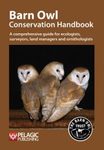![Eleonora's Falcon Eleonora's Falcon]()
Click to have a closer look
About this book
Contents
Related titles
About this book
Named after a Sardinian princess of the fourteenth century who established laws protecting falcons, Eleonora's falcon is the only European bird to breed in autumn and feed its brood on the mass of birds that migrate from Europe to Africa between July and October. It breeds on small Mediterranean islands in colonies of up to 200 pairs and hunts often in groups, preying on more than 90 species of migrant birds. During the winter this falcon visits the rain-soaked woodlands of Madagascar.
In this study – illustrated beautifully and extensively with 59 line drawings and 38 photographs – Hartmut Walter shows how the unique geographical and biological situation of Falco eleonorae makes the species' health an important indicator of environmental decay. For though it lives in relatively isolated areas, Eleonora's falcon nevertheless may ingest the many pollutants contained in its diet of birds migrating from industrial Europe. Walter, who has studied raptors on several continents and has been an ornithologist since his early youth, examines several discrete colonies of Eleonora's falcon. He concentrates on the species' intraspecific behavior and ecology – such as the falcons' aggressive actions, hunting strategies, and response to fluctuating environmental conditions – and investigates their evolutionary past.
Contents
Acknowledgments
1. Studying Falcons
Background
Study Aims
Itinerary and Study Plan
Field Identification
2. Geography
Distribution
Breeding Habitats
Population Status
3. Population Ecology
Colony Size and Structure
Clutch Size and Breeding Success
Egg-laying, Incubation, and Hatching Time
Growth Rates of the Young
Mortality and Its Causes
4. The Hunting of Migrant Birds during the Breeding Season
Division of Labor
Hunting Area, Period, and Techniques
5. Bird Migration in the Falcon's Breeding Areas
Structure of Bird Migration
Eleonora's Falcon and the Migration Pulse
Conclusions
6. A Further Analysis of Raptor/Prey Interactions
Hunting Success
Selective Hunting
Killing the Prey
Antiraptor Behavior of Prey Species
Hunting Behavior from April to July
Switch from Insect-Hawking to Bird-Hunting
7. The Falcon's Prey
Methodology
Nature of Prey Remains
Insects and Other Nonbird Food
Analysis of Bird Remains
Prey Remains at Paximada and Mogador
Prey Biomass and Falcon Energetics
Impact of Eleonora's Falcon on Bird Migration
Are Prey Remains a Mirror of Migration Density?
Analysis of Prey Migration Patterns
Summary and General Conclusions
8. Patterns of Falcon Behavior
Study Methods
Sexual Behavior
Territorial Behavior
Agonistic Behavior
Acoustic Behavior of Eleonora's Falcon
Behavioral Development of Young Falcons
General Discussion
9. The Nonbreeding Season
Departure from Breeding Areas
Fall Migration
Geography of the Winter Range
Falcon Ecology and Behavior
Spring Migration and Return to the Mediterranean Region
Geographical Dispersion of Juveniles and Subadults during Spring and Summer Months
Discussion
10. Evolutionary Ecology
Comparing Atlantic and Aegean Populations
"Absent" Caribbean Niche
Origin of Eleonora's Falcon
11. Human Impact
Discovery of Eleonora's Falcon
Princess Eleonora of Arborea
Medieval Falconry in Sardinia
Fishermen and Other Predators
Indirect Effects of Human Endeavor
Future of Eleonora's Falcon
12. Eleonora's Falcon and Other Birds of Prey: A Comparative Analysis
Adaptive Value and Function of Morphological Characters
Dispersion, Territoriality, and Sociability
Selection and Occupancy of Nest Sites
Breeding Behavior
Predator/Prey Relationships
Reversed Sexual Dimorphism in Raptors
Raptor Research
Appendixes:
A. Tables 25-38
B. Hunting, Feeding, and Food-catching Behavior
C. Records of Falco eleonorae from Madagascar, Réunion, and Mauritius
D. Genetic Base of Color Dimorphism
References
Index
Customer Reviews




































